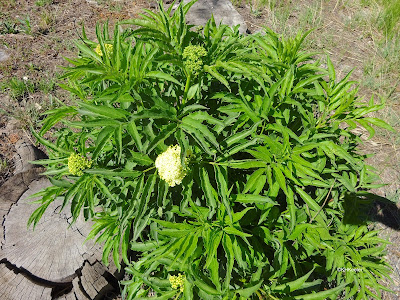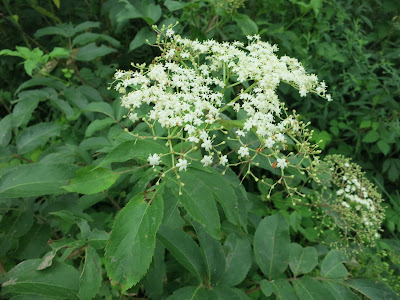Species in the genus Sambucus are called elder. That somehow doesn't sound right to my eastern North American ear, so I always say elderberries. That name I prefer is clearly weird--the tree doesn't always have berries, or the berries are just the fruit of the elder--but I'm not alone in this speech pattern, you can see it in a lot of U.S. writing. Historically and properly, it was elder, but bear with me, I keep sticking -berry on the name.
 |
| Elderberry with berries |
The various elderberry species are native all over the world, in temperate and subtropical areas. Because they are useful and edible, people have cultivated them for millennia and spread them further. In expert publications, the number of species of elderberry, Sambucus, has gone as high as 38 and as low as 8. The plants are quite variable and lack the neat patterns needed for species that everyone will agree on. The discussion is ongoing.
Some Sambucus species are local endemics, like Sambucus palmensis found only in Canary Islands, and what you call them doesn't complicate many people's lives. However, the paper that created only eight species, R. Bolli's 1994 Ph. D. thesis, combined the common elderberries of Europe and North America. The oldest name was Sambucus nigra, black elderberry, a plant with a native range of North Africa, Europe and west Asia, which has been cultivated since ancient Greece and probably longer. Bolli merged the common elderberry of eastern North America, called the American black elderberry, or Canada elderberry, Sambucus canadensis, and the the common elderberry of western North America, blue elder or blue elderberry, Sambucus cerulea, with black elder, recognizing the American plants as subspecies. Some people have agreed with Bolli, others have maintained the American plants as independent species. The result is that you can find the same plants, the most abundant and visible American elderberries, given two different scientific names.
 |
| a small cultivated elderberry plant |
European black elderberries were of course introduced to North America early during European settlement. They have naturalized all across the continent and doubtless cross with the American native elderberries. That makes it all the harder to separate out elderberries if you suspect several different species. However, it does make it easier for me, blogging about it, to say, "elderberry" or "black elderberry" and refer to most of the elderberries you are likely to encounter.
The chaos extends to deciding to what plant family elderberries belong. In the middle 1900s they were in the Caprifoliaceae, the honeysuckle family. Then, as DNA evidence became available, they were briefly in their own family, the Sambucaceae, then merged into the adoxa family, Adoxaceae. When, this week, I checked the Angiosperm Phylogeny working group, one of the most influential sources of plant classification, the family Adoxaceae no longer exists, and Sambucus is in the viburnum family, Viburnaceae. (The World Flora Online and Kew Garden's Plants of the World Online both agree, Viburnaceae.) That is why when you look up elderberries, the sources may give you different plant families as well as different scientific names. I have no idea if being in the Viburnaceae will last.
 |
| elderberry with unripe fruit |
The berries of black elderberries are edible and have been used for food everywhere they grow. The plants are pretty well defended by compounds that break down to release cyanide, sambunigrin, and so, not good to eat. However, by the time the fruits are fully ripe, they contain virtually none of those compounds. Historically as well as today, elderberries distributed their seeds by packing them into delicious berries that birds (and other animals but especially birds) ate and then dropped elsewhere in their feces. Across all the wild elderberries, some are sweeter than others, some pretty bitter, likely indicating more or less of the cyanogenic compounds.
The poisons are much more concentrated in stems and leaves than flowers and fruit. People have cooked with elderflowers and made elderflower wine as well. The ripe berries are generally safe to eat raw but they can be made even safer by cooking, because that destroys the cyanogenic compounds.
Furthermore, poisoning is a function of dosage. The poisoning symptoms start with nausea, then vomitting and diarrhea. There seems to be only one well-documented case of elderberry poisoning in North America in the last 50 years; a group on a retreat made elderberry juice from native elderberries in California (Sambucus nigra ssp. cerulea). They mashed elderberry fruits, the stems, and some leaves, added sugar and apple juice. The people who had five glasses of the juice were the sickest, although only one was hospitalized, very uncomforable but not in life-threatening condition. People who drank less juice had milder symptoms.
 |
Red elderberry, Sambucus racemosa, a distinct North American species that is readily recognized by its red berries, is considered poisonous, including the berries. However, numerous Native American tribes ate red elderberries. When you look carefully, they ate the berries dried or cooked and as wine, all treatments that reduce their toxicity.
Black elderberries are widely grown or foraged to make jam or pie or wine, or other uses of berries. Delicious!
 |
References
Anonymous. 1984. Poisoning by elderberry juice--California. CDC (Center for Disease Control, US) MMWR (Morbidity and Mortality Weekly Report). link (Accessed 1/26/24)
Appenteng, M. K., R. Krueger, M. C. Johnson, H. Ingold, R. Bell, A. L. Thomas and C. M. Greenlief. 2021. Cyanogenic glycoside analysis of American elderberry. Molecules. 26 (5): 1384.
Applequist, W. L. 2015. A brief review of recent controversies in the taxonomy and nomenclature of Sambucus nigra sensu latu. Acta Hortic. 1061: 25-33.
Bolli R. 1994. Revision of the genus Sambucus. J. Cramer. Berlin. this is the key taxonomic paper but I haven't seen the original.
Moerman, D. E. 1997. Native American Ethnobotany. Timber Press, Portland, OR. Online: link (Accessed 1/26/24)

This post is really interesting to me. It's nice that you are giving so much of information about plants and flowers with names along with the beautiful pictures!
ReplyDelete